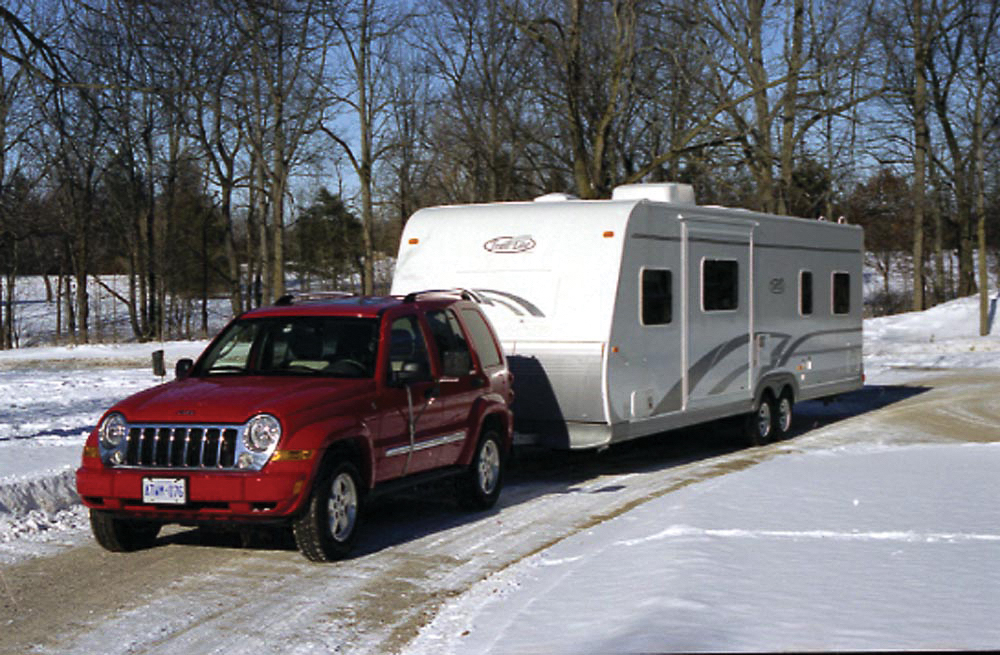Tips for RV Thrills – not RV Chills
By Garth W. Cane
This article originally appeared in RV Lifestyle 37-1
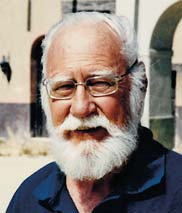 Over the years, many RV Lifestyle readers have asked about the techniques of travelling by RV in cold weather – here are some tips for those hardy souls who see winter as an opportunity to enjoy the great outdoors!
Over the years, many RV Lifestyle readers have asked about the techniques of travelling by RV in cold weather – here are some tips for those hardy souls who see winter as an opportunity to enjoy the great outdoors!
Winter touring requires all of the pre-trip planning of the usual RV adventure, plus some special considerations to combat the cold. If your RV has been in storage for more than a day or so, it will more than likely be cold and damp – to get the chill out of the vehicle prior to your winter trip, plan to start the process at least two days before your scheduled departure. The first step is to bring your RV or motorhome to a place where you can plug in the electrical cord. If winter has set in, your RV will be as cold inside as the weather is outside – if there has been a real cold snap during the previous few days, it may even be colder in the RV than outside! Obviously, your primary goal in preparing for your trip will be to start the furnace to allow the inside to warm up – to fully chase the cold from the vehicle, this process can take a day or more, and you have to allow access for the warm air to permeate the whole vehicle. There are a few tricks to speed up the process – open all cabinet doors to allow the warm air to circulate, and place an electric blanket directly on top of the mattress (without any covers on it) and turn it on to chase away any dampness in the mattress. If you have a motorhome, you will be able to keep the warming process going as you travel – if you have a trailer you should leave the furnace running at about 55 degrees to keep the interior reasonably warm, then boost the heat to room temperature when you arrive at your evening destination – the RV furnace should be able to provide comfortable interior temperatures in a reasonably short time.
Assuming that you have winterized your water system, do not be in a hurry to re-activate the plumbing – leave the antifreeze in the water lines until you are in an area where it will be warmer before you flush the system out with fresh water. You may have to stay one night in a truck stop or shopping center as some of the campgrounds may not be open yet on the route to your destination.
For winter weekend excursions, carry fresh water in 5-gallon poly bags stored on the floor of the shower. This is sufficient for coffee, tea, and for the dog until after the first few days on the road. Do not fill the water tanks unless you are going to be on the road for an extended period. We use the bypass to prevent the water from entering the water heater until we are in warmer climates as the heater is exposed to outside temperatures. Flush the toilet with windshield antifreeze. This could eventually cause a problem with the seals in the dump valve, but new seals are much cheaper than replacing burst pipes. During the day, when you are not in the RV, lower the thermostat to about 50 or 60 degrees F to conserve propane. The RV will warm up very quickly when you return and turn up the heat.
At some ski areas, we have stayed on the parking lots overnight after asking permission, but make sure that the exhaust pipe for the generator is not buried in a snow bank. At ski areas, you sometimes have to move the RV in the middle of the night to a different location when you hear the snow plough getting close as it clears the parking lot; this is much easier if you are using a motorhome than a travel trailer.
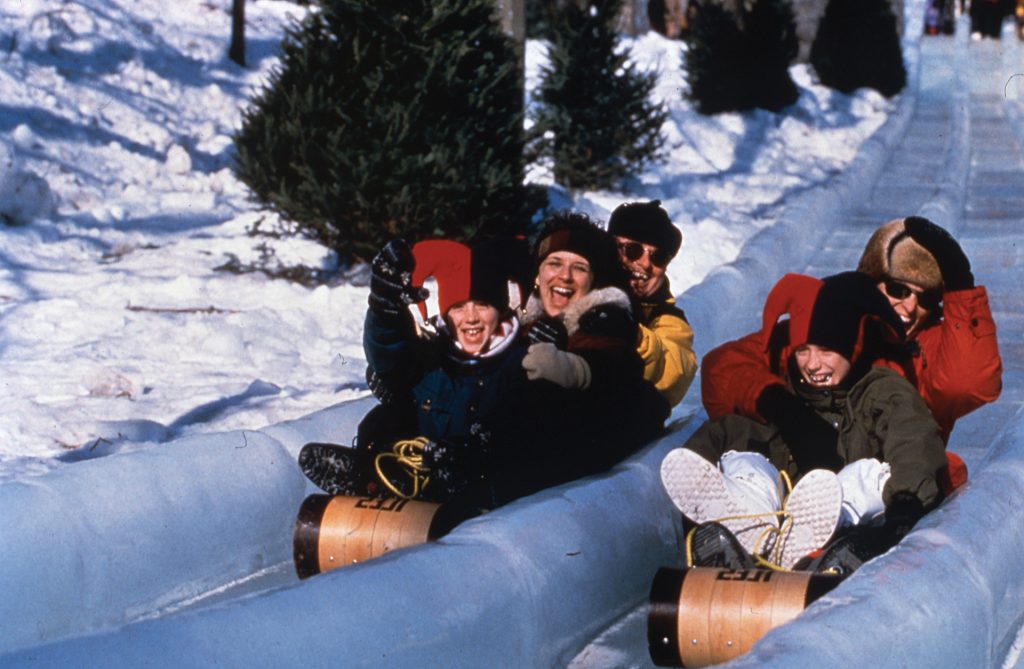 When we visited our favourite campground at a ski area, we would call ahead to be sure that the owner had a site ploughed out for us when we arrived. Most ski areas have a lodge where you can use a clothes dryer to dry the kids’ clothes for the next day. In some ski resort areas where we have stayed, they have movies in the evenings to entertain the young ones. These days, we have a satellite TV system on our motorhome, so as long as the trees are not towering over the unit, we can provide our own entertainment.
When we visited our favourite campground at a ski area, we would call ahead to be sure that the owner had a site ploughed out for us when we arrived. Most ski areas have a lodge where you can use a clothes dryer to dry the kids’ clothes for the next day. In some ski resort areas where we have stayed, they have movies in the evenings to entertain the young ones. These days, we have a satellite TV system on our motorhome, so as long as the trees are not towering over the unit, we can provide our own entertainment.
If you are going to go camping for the season in a cold location, it is wise to install temporary storm windows to prevent cold drafts from coming off the windows and down your back as you sit on the sofa. In the past, we have taped construction type (mil-roll) clear plastic temporarily over the windows with masking tape. When we used to ski more often, we had a set of Plexiglas storm windows made to fit our motorhome. We stuck some 1/2-inch foam insulating tape around the edges to give some dead air space between the windows. The “storm windows” were held in place by small butterfly-type fasteners.
Winterizing your Campsite
If you are parking your RV at your favourite ski hill or snowmobile spot for the weekend, or for longer periods of time, you will need to use a short water hose wrapped with heat tape and insulation to protect it from freezing if you need the water hooked up at all times. Pile straw bales under the edges of the RV to keep the cold winds away from under the floor. It is also best to rig up a portable entry shelter so that the cold winds do not blow in each time you open the door. We would use this area to clean the snow off our boots before entering the RV. A piece of plastic just inside the doorway will catch any snow that you have missed. Any snow on this plastic can then be thrown out the doorway. It would be best to have a 100-pound propane cylinder outside instead of the usual 30-pound tanks on the tongue of the frame of a trailer. Your campground operator will help you arrange an agreement with the propane supplier to come and refill it when needed.
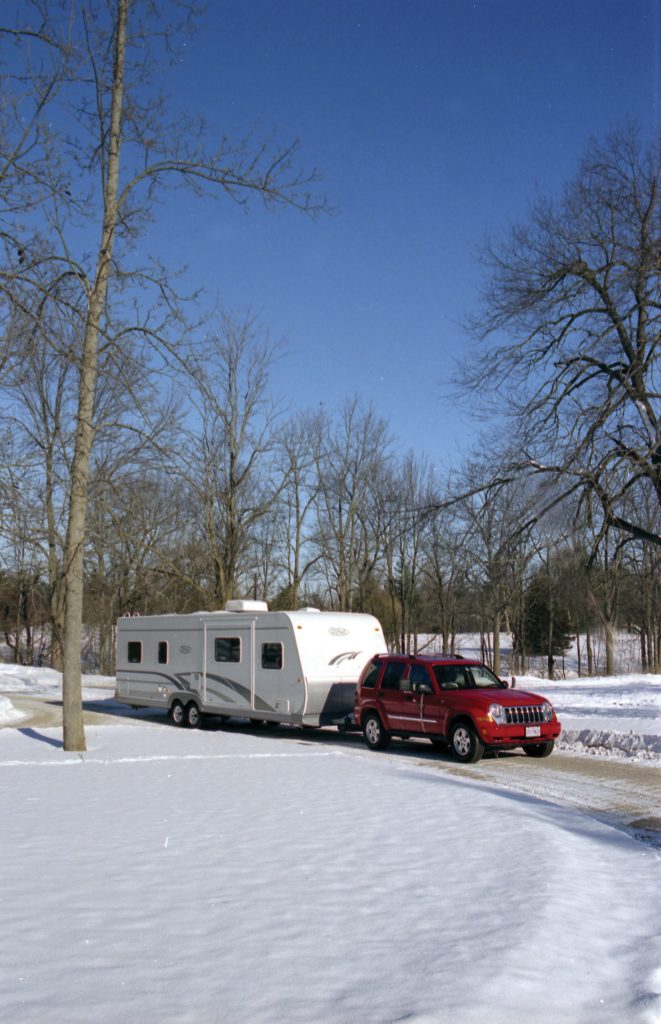 We often take our motorhome to the RV shows in Eastern Canada, and when we use the RV to live in while we are at an RV Show, we find out where we will be able to have our propane tank filled long before we need LP gas. Whenever possible, we plug the RV into a power source, and we use a small ceramic heater to help conserve the propane supply.
We often take our motorhome to the RV shows in Eastern Canada, and when we use the RV to live in while we are at an RV Show, we find out where we will be able to have our propane tank filled long before we need LP gas. Whenever possible, we plug the RV into a power source, and we use a small ceramic heater to help conserve the propane supply.
Additional Considerations…
You can lose quite a bit of heat through your roof vents – even if they are closed. There are special 14-inch pillow-like cushions available from camping suppliers that fit into the roof lumidomes to insulate them. It is very important to note that you have to remember to open the lumidome above the stove whenever you are cooking so that the stove can get enough fresh air for combustion and not produce carbon monoxide. You must also be aware that the carbon monoxide detectors that are used in RV’s and homes have a finite lifespan – after a few years they may not be able to detect the CO gas – even if the little light says that the unit is working properly – check the detector for an expiry date, or a date of manufacture, then contact the manufacturer to determine when the unit should be replaced.
You may have to balance the need to stop all cold draughts, with the need to maintain proper humidity levels within the RV. If you don’t have enough ventilation, the windows will steam up with condensation from the moisture given off your bodies and during cooking.
Be Road-Wise…
Before driving down a strange country road in the winter, try to find out as much as possible about the route and the road conditions ahead. It is not fun to be stuck between two hills and not be able to get up one, or back up over the other. There are many local considerations as well – for example, if you travel during the winter in Colorado, you should have a set of chains for the rear wheels. Some popular models are made by Rud-Chain – the highway patrol won’t let you on some of the forest roads without suitable chains.
Schedule at least one extra day of travel time, in case the weather turns ugly and you have to stay overnight at a highway service area or shopping centre until the snow ploughs go by. You should always have sufficient food, water and heat to be comfortable for an extra night or two, even longer if you travel far off the beaten path.
On slippery roads observe the three “O”s. Don’t Overpower as this can cause the rear wheels to skid – apply the accelerator smoothly when accelerating. Don’t Over brake as this can cause the rear end of your tow vehicle or motorhome to break loose and your trailer to slide around behind you. You don’t want the trailer brakes set up too high, as the wheels could lock up and cause the trailer wheels to slide. You want the wheels on the trailer to keep rotating as you come to a complete stop. With ABS, apply the brakes and keep the pedal depressed. If you lift your foot off the brake pedal, it stops the ABS system from working. The ABS system will allow you to continue steering the direction that you want to go. Don’t Oversteer, make steering corrections smoothly – if you try to turn the steering wheel too quickly, the wheels could turn further than you want them to – and cause the front wheels of your vehicle to snowplough ahead in the same line that you were travelling.
When you are driving at night, if your headlights do not reflect off the road, or the road looks black – you are more than likely on what is called black ice. It is a smooth layer of ice that is formed when the sun melts the snow during the day and then the moisture freezes smooth as the sun goes down or the temperature goes below freezing. If you get on black ice – try not to do any steering or braking maneuvers until you are past it. Continue in a straight line if possible. Until you get to a warmer area it is a good idea to try to drive only in the daylight if possible, as it is easier to see what is ahead of you. If you have to drive at night, remember that your headlights do not shine as far ahead as the distance you need to stop.
Drive defensively.
Experienced RV travellers become familiar with their favourite routes, or ask the locals for insights into the specific road characteristics. For example, if you are travelling south on I-75, you will usually get to better weather as drive south of Cincinnati. You should also plan ahead to determine where the camping facilities are open – if we are going south on I-69 (from Sarnia to Louisville) we generally stop at the Fort Worth -Auburn KOA that is open all year. The KOAs at Louisville, KY, and Nashville, TN, are also open all year, and have heated water outlets to keep them from freezing.
Check the topographic map – if we are going south on I-75 in the winter, we turn west on I-71 just after Cincinnati and head towards Louisville to avoid the long hill going into Knoxville. We continue south on I-69 to Nashville, and then take I-24 back over to Chattanooga. This only adds about 50 miles to your trip compared to the route going straight down I-75, but the hills are not as steep or slippery. On the way home, there is no problem taking I-75 all the way as you are now going to be driving down the Knoxville hill.
Stay Warm and Dry…
Before we stay on a shopping centre lot in the winter, we always go in, buy a few things at the grocery store, and ask the manager for permission to park overnight or until the storm passes. Often they have shown us where there is an outside electrical outlet around back.
Our motorhome is equipped with a winter insulation package. It has an extra layer of foam-core insulation between the fibreglass insulation and the outside panels, and heat is ducted into the holding tank and dump valve areas. This prevents the pipes from freezing as long as the furnace is working.
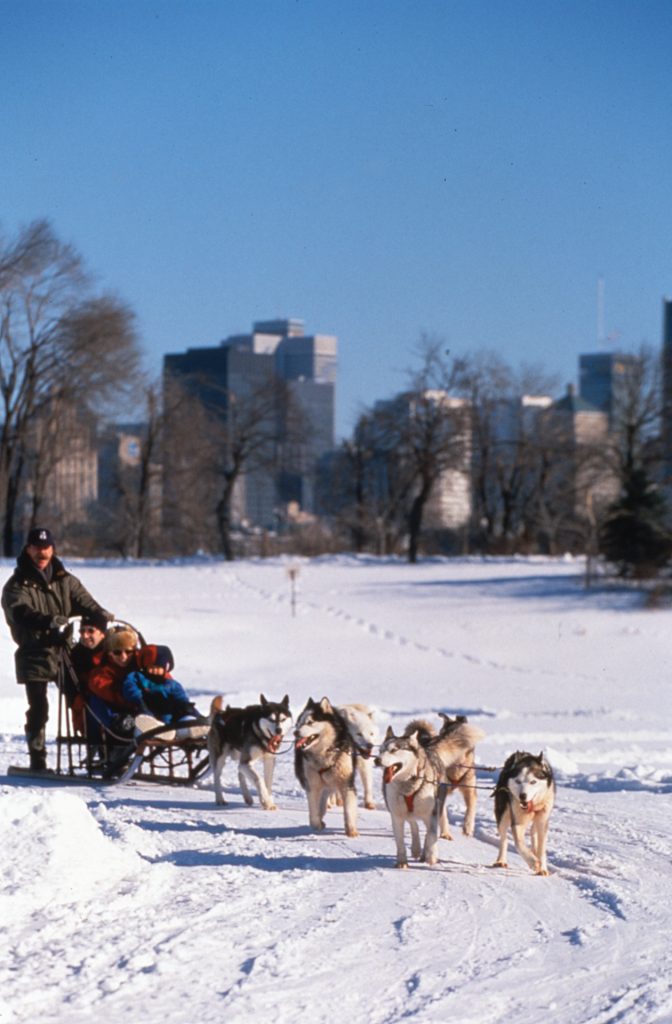 When people order a new RV they can often add the extra insulation package as an option. If you are purchasing a used unit, the only way that you could see if it has the extra insulation is to look in openings like the door striker area. Most fresh water piping is inside the RV, so as long as the RV is warm, and air is able to circulate inside the cabinets and cupboards, the pipes should not freeze. Nevertheless, remember to keep your waste tanks and termination valves warm or protected by antifreeze.
When people order a new RV they can often add the extra insulation package as an option. If you are purchasing a used unit, the only way that you could see if it has the extra insulation is to look in openings like the door striker area. Most fresh water piping is inside the RV, so as long as the RV is warm, and air is able to circulate inside the cabinets and cupboards, the pipes should not freeze. Nevertheless, remember to keep your waste tanks and termination valves warm or protected by antifreeze.
Many companies offer extra insulation packages. Some units that have heated basements may lose a lot of the heat, as the lower compartments may not be well insulated. Pipe heaters are available from Ultra-Heat that wrap around the pipes and elbows. They also sell heating pads that can be installed on the bottom of the waste tanks. These specialty heaters operate on 12-volts while you are driving and on 120-volts when you are in a campground or have the generator running, and they will effectively keep the drainpipes from freezing. There is also a company called Hi-Tech Heat that supplies radiant electrical heating pads for the floor surfaces. They are designed to be placed under the floor tiles or hardwood during construction of the RV. This works as long as you are plugged into normal 120-volt electrical outlets or have your generator operating.
For more information on the auxiliary heaters check out: www.ultraheat.com, www.hi-techheat.com.


















